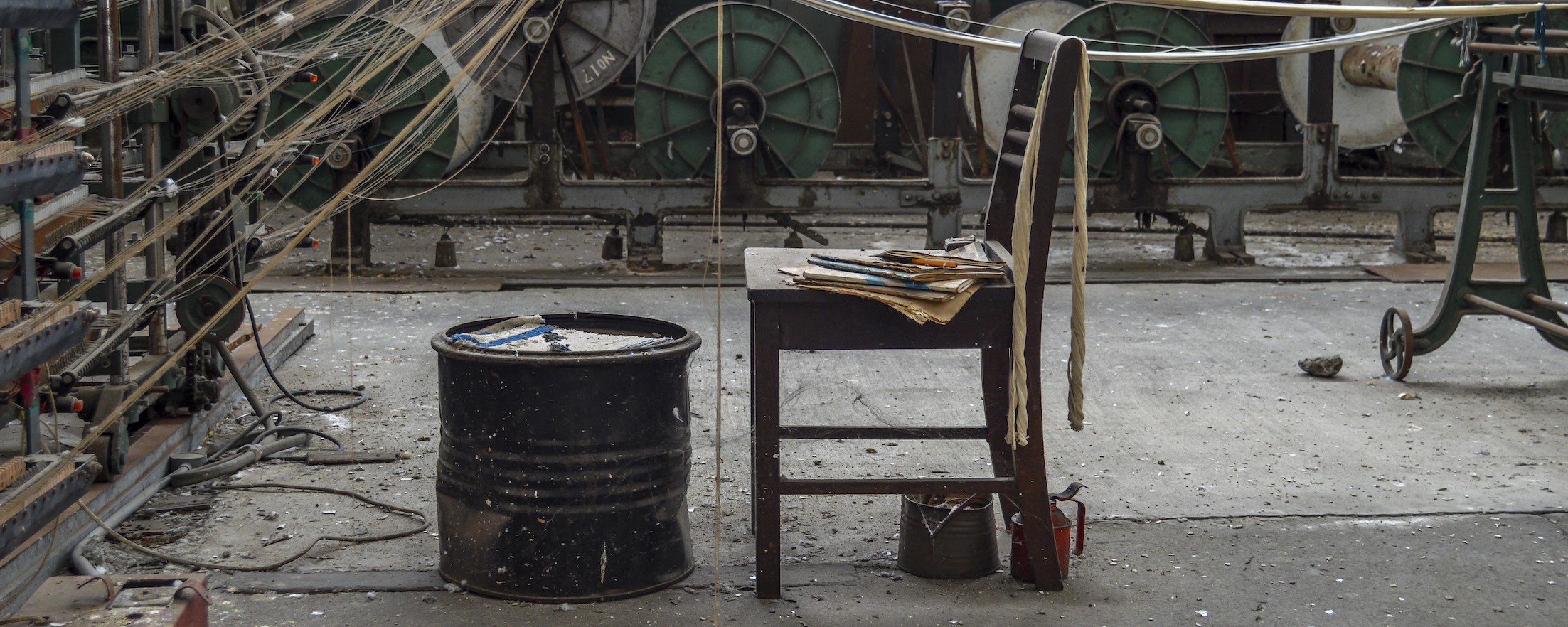

Mou Thavy smelled something noxious and foul, just before the darkness set in. When the 24-year-old woke up in Chey Chumneas Hospital, another woman lay in the bed beside her. They had been placed head to toe, their backs grazing. The beds around them were occupied, too. At least 20 workers had collapsed within the span of several minutes at the Chinese-owned Lin Wen Chih Sunstone Garment Enterprises Co. just south of Cambodia’s capital city, Phnom Penh, on the morning of February 9, 2016.
Workers said later that they had lost consciousness after inhaling a chemical smell emanating from a dye kiln that operated overnight, coupled with the heat generated from closed windows and switched-off fans. The hot season hadn’t yet hit, but at the height of the day, temperatures hovered around 87 degrees Fahrenheit [30 degrees Celsius]. An inspector who visited the company denied this, saying the incident was not chemical or heat related, but the result of a lack of sleep and stress, according to local news reports at the time.
It was one of the first incidents of mass fainting in Cambodia’s garment industry this year, which has since seen hundreds more fall ill while on the job in factories that produce everything from Adidas sneakers and Gap T-shirts to wedding gowns, almost exclusively for foreign companies that sell to consumers in more prosperous nations like the United States.
The explanations for why hundreds, sometimes thousands, of women fall unconscious each year while at work in the garment industry are wide-ranging. Many say it is simply due to excessive heat and over-work. Some psychologists have claimed it’s the result of mass hysteria that triggers workers to fall like dominos within the claustrophobic warehouses.
But workers often report smelling something fetid before they faint, and chemical exposure–either from the products workers are handling or from pesticides sprayed in or near the factory–is frequently cited. Chemical safety experts and human rights advocates say chemicals are a common and dangerous reality of working in the garment industry. And incidents of mass fainting are just the tip of the iceberg.

“It is more time-consuming to find the chemicals’ long-term effect than we thought “¦ Sometimes it might be too late, [and] when we figure out the problem, the chemical has already been sold for many years.”
On occasion, the air outside the factories that flank the road between Phnom Penh and Kandal province becomes choked with unidentified fumes. I traveled this road many times while reporting on a story at a children’s hospital in Kandal province for The Phnom Penh Post in 2015. While working in the newsroom, reports of deplorable working conditions and exploitation in the country’s $6-billion garment industry were commonplace. In a country of more than 550 garment factories, the nearly 700,000-person workforce is largely female. Most workers are only given short-term contracts, which guarantee little income security and make it easy to fire workers in the event of illness or pregnancy, rather than granting leave. Workers regularly hold protests as if they are vigils, objecting to unfair pay and working conditions.
Safety hazards arise just from traveling to work. Packed tightly together and standing upright in the beds of trucks, Cambodia’s garment workers are transported early in the morning each day from rural communities to their jobs at the factories on the city outskirts. This year alone, three trucks packed with workers crashed while en route to a factory, injuring hundreds and killing at least five people, including a pregnant woman. It is also not uncommon for employees to arrive at work only to find the factory has been deserted by the owner, leaving workers unpaid and suddenly unemployed. They protest this, too.
But these are the more blatant risks. Less visible–not just in Cambodia but across other developing nations as well, where an estimated three-fourths of the world’s garments are manufactured–are the ramifications of harmful chemicals used in all manners of fashion production.
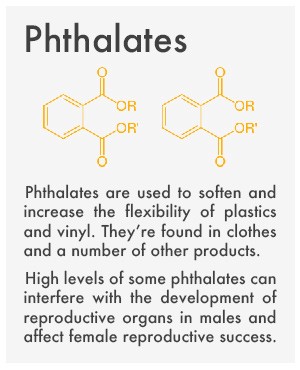
Chemicals are a prominent and necessary tool for garment manufacturing, used to color, clean, soften, stiffen, or transform raw materials into malleable fabric.
But many of them, which are often added as a way to create more marketable products–like wrinkle-free pants sprayed stiff with formaldehyde, a carcinogen also used to preserve dead bodies–can have dangerous complications, particularly when their use is not monitored rigorously, nor protective wear provided to workers in the factories where the chemicals are applied.
In Cambodia, the most frequent hazards to garment industry workers comes from breathing the chemical dusts that results from cutting and stitching fabric, and from exposure to the chemicals used to dye or clean the cloth, found the International Labour Organization.
At least 40 different harmful chemicals are used to manufacture clothing and shoes in the country’s factories. In 2014, Leng Tong, director of Cambodia’s Labour Ministry’s occupational health and safety department, said these chemicals were not being properly monitored and urged factories to provide the government with chemical safety data sheets to better protect worker’s health, reported The Phnom Penh Post. His comments came after 200 workers fainted in a single morning in the King Fashion garment factory in the Dangkor district, which produces clothes for the Swedish owned H&M and South Carolina-based Hanes. In 2011, the same factory saw 300 people drop in a single day. But the first six months of 2014 were unique: More than 1,100 people fainted while working in garment factories.
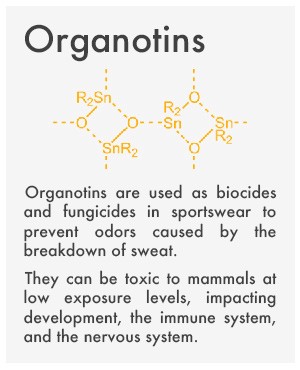
Day after day, as harmful chemical dust and fumes are inhaled, ingested, and come in contact with skin, workers can experience immediate and long-lasting effects ranging from skin irritation and allergic reactions, to lung or organ damage.
Greenpeace identified a list of 11 of the most dangerous chemicals commonly used in the industry as part of the advocacy group’s efforts to educate and encourage companies to develop more environmentally sound and safe operations. Among them are azo dyes, acid-based colorants that account for 60 to 70 percent of all dyes used by the textile industry. While the European Union banned azo dyes from production in 1991 because, when the chemical compound breaks down, it releases aromatic amines into the atmosphere that have been shown to cause cancer, this doesn’t prevent manufacturers from employing the chemicals in factories outside the EU.
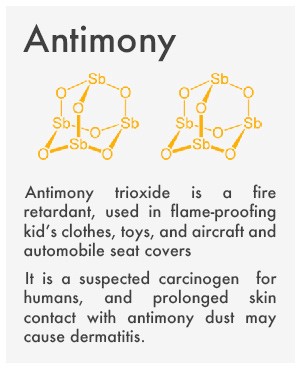
Alkylphenol, also included on the list, is used in dyes and detergents. Not only can it do lasting damage to the environment, but it can also act as an endocrine disruptor, creating hormone imbalances that cause tumors to grow inside body tissue.
In 2004, the United Nations Environment Program conducted a national profile on Cambodia’s chemical use and found that its garment industry uses more than 49,000 tons of chemicals annually. Obviously not every chemical used in manufacturing in toxic–after all, water is a chemical–but the issue is the rate at which new processing chemicals are introduced without supervision.
“Workers of some garment factories are often exposed to noxious chemicals but the detailed study or investigation of these incidents or the toxicity of any substance has not been made,” UN researchers wrote at the time.
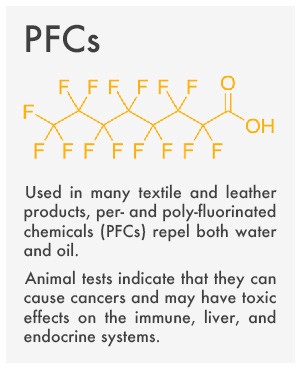
Huantian Cao, co-director of Sustainable Apparel Initiative for the University of Delaware, said part of the reason for this is the discrepancy between the pace at which new chemicals are created and the time it takes to assess them. Over 1,000 new chemicals enter the market each year in the United States.
“It is more time-consuming to find the chemicals’ long-term effect than we thought,” he said, noting that analysis can take years, or even decades to really understand the ramifications. ” “¦ Sometimes it might be too late, [and] when we figure out the problem, the chemical has already been sold for many years.”
One of the most blatant example of this, outside the garment industry, is Agent Orange, a now-banned herbicide used to defoliate Vietnam’s forests during the Vietnam War. It was 30 years before the United States finally recognized a wide range of more than 15 life-threatening conditions that resulted from exposure; among those, afflicted U.S. veterans were diagnosed with lung and prostrate cancer, and Parkinson’s disease.

“That shift of relocating industry to the developing world, that is essentially the story of globalization.”
Protecting workers, the surrounding community, and even consumers from chemical exposure can be a seemingly insurmountable task. It’s one that has been ongoing for decades, said senior researcher for Human Rights Watch Richard Pearshouse, who has investigated chemical exposure in Bangladesh’s leather tanneries. “That shift of relocating industry to the developing world, that is essentially the story of globalization,” he said in an interview. “And globalization is as old as humanity.”
As European and North American countries developed stricter labor and environmental laws over the past several decades, companies increasingly moved overseas to avoid the cost of operating under heavy regulation. It follows, then, that the burden of environmental contamination and worker health risks have been transferred onto developing countries.
There’s data to prove it. Alkylphenols levels were found to be significantly higher in Cambodian water and sediment–and in seven other Asian countries–when compared to European nations, according to a 2012 U.S. National Institute of Health study.
Even when countries in Asia or South America have protective laws on the books, enforcement is rare, if not entirely overlooked, Pearshouse said. The extent of chemical use is often excluded from product labels, he added, and progress to create protective working environments has been slow-moving.
In 2011, Pearshouse spent several months in Dhaka, Bangladesh, interviewing workers and the community in one of the world’s most polluted cities: pollution that has resulted from a particularly toxic sector of the leather manufacturing. The resulting report for Human Rights Watch report, “Bangladesh: Tanneries Harm Workers, Poison Communities,” was one of the first examinations into the unsettling impact of the industry’s chemical contamination in an unregulated environment.
In Hazaribagh, a neighborhood in Dhaka where 90 percent of the country’s factories are located, more than 200 tanneries dump 21,000 cubic meters of untreated chemical runoff, including lead and chromium, into gutters each day, the report found. From the gutters, this runoff feeds directly into the city’s main waterway, the Buriganga River, causing the water to take on a grayish pallor and churn with bubbles as if the entire system had been warmed to a soft boil. Children play and bathe in it. Many, as young as 11, also work in the factories.
“You are using hundreds if not thousands of chemicals in a tanning process, some of those chemicals we know are extraordinarily nasty. But the vast majority of those chemicals and how they interact is unknown. It’s just unstudied,” Pearshouse said, adding that some of these chemicals can rub off on the final product and impact the consumer, too. But, of course “the people on the frontline are the workers,” he said.
The work of turning animals skins into low-quality leather is done in Hazaribagh by bathing the pelts in pits of acid, which are then churned in enormous wooden drums with chromium sulfate, and stretched and treated with formaldehyde. Chromium sulfate and formaldehyde are listed as known carcinogens by both the American National Cancer Institute and by the U.K.’s Health Protection Agency.
In Bangladesh, like Cambodia, laws exist that require industries to abide by environmental standards and enforce worker protection practices. But Pearshouse said government officials told him that they have a hands-off policy in Hazaribagh. The Ministry of Environment admitted that it does not monitor what is in the air, water, or soil surrounding the the Buriganga River. And Human Rights Watch reports for both countries have found that enforcement of these regulations rarely makes it off the legal page into practice.
Aprons, gloves, masks, and other required protective wear are also rarely distributed or the policy enforced by factory managers. The work in the tanneries is most often done in flip flops and short pants. Videos taken by Human Rights Watch show workers handling buckets of chemicals in cotton pajamas, with bare hands and unmasked faces.
“When the water touches your skin, it causes sores that itch at night,” one worker told Human Rights Watch in the video. Others complained of respiratory problems, skin lesions, and stomach pain.
In a Hazaribagh warehouse, the video shows a girl using a metal rod to douse the leather pelts, stacked like piles of thin gray corpses, into sloshing pools of acid. Her legs are bare and her feet clad in open sandals.
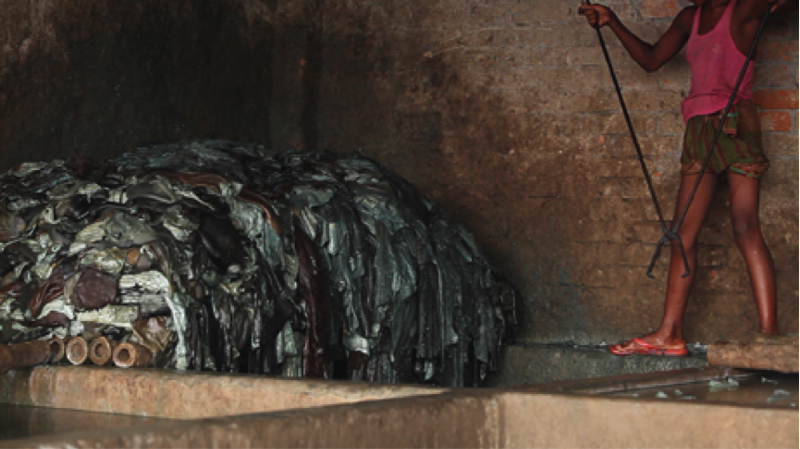
But the industry has continued to grow, increasing by nearly $40 million each year since 2001. In July of 2012, Bangladesh exported around $663 million of leather material and goods, including footwear, to 70 countries. The garment industry is credited with more than 80 percent of Bangladesh’s exports and at least 20 percent of the nation’s GDP. The labels of this leather, however, do not read, “Made in Bangladesh.” They credit the country where the ultimate product is stitched, giving consumers little clue into the type of fashion they are investing in.
Pearshouse returned to Hazaribagh in April to find, “Not much has changed. The scope of the problem and the conditions of the workers are still the same,” he said. “It’s a much bigger problem than anyone is talking about.”

“Dead bodies of young women on the evening news–this must change something.”
Just after Pearshouse left Bangladesh, another incident brought the dangers of of Dhaka’s garment industry into the international spotlight. On November 25, 2012, the Tazreen Fashion factory, a nine-story building on the outskirts of Dhaka, caught fire, the flames stoked by piles of fabric and barrels of chemicals. More than 100 workers died, many throwing their bodies through glass windows on higher floors and jumping to their death. The BBC showed thousands of local residents standing in front of the destroyed site and wailing in mourning for their loved ones.
A local broadcast reporter said fires like this were common, but the scale raised questions about workers safety in the garment factories on a global level. Just five months later, a garment factory in Rana Plaza, also in Dhaka, collapsed, following an inspection that revealed flaws in the building’s foundation. Photographs showed the center of the sand-colored, multi-story building crumpled in, with reams of bright blue fabric streaming down the facade and people climbing the remains looking for the dead. At least 134 people were killed and more than a thousand others injured. The factory produced inexpensive clothes for brands sold at American superstore Walmart.
Susan Egan Keane, deputy director of the health program for the Natural Resources Defense Council (NRDC), said she thought this would be a moment that could spark substantial change and raise public awareness about the realities of the garment industry.
“Dead bodies of young women on the evening news–this must change something,” she said of watching the news reports from the building’s collapse. She thought it might affect buyer behavior or corporate accountability. “And, not really,” she lamented.
“It is the responsibility of the factory owner and the buyer to makes sure there are occupation safety standards in place,” she said, adding that these measures “shouldn’t be in response to community health crisis–it should be in response to known hazards.”
Part of what inhibits this responsibility, she explained, is a lack of transparency within the supply chain–it can be difficult to trace the path from where cotton is grown, treated, sewn, and shipped, she said. But many buyers are more interested in the bottom line, and profit margins improve significantly when working in developing nations where health and safety violations are largely overlooked. “They are companies, they make money,” Keane said. “I think they just didn’t think about [the supply chain] until they were forced to think about [it].”
Keane said the large amount of chemicals and formulations can make it difficult for factories to realize the complexity or risks combined within a formula like, say, “red dye number 1”; factory managers are wary to try new, safer formulas because their profits depends on the result: an exact shade of black or the specific softness of a garment. “Manufactures are under a lot of pressure to meet the exact specification of their clients,” she said. “They can waste a lot of money if they don’t.”

“None of those [problems] are NASA flights to Mars. These are things that can be addressed. It requires concerted efforts, and willingness to take action.”
Progress, Keane said, is possible. “None of those [problems] are NASA flights to Mars. These are things that can be addressed. It requires concerted efforts, and willingness to take action,” she said, and making small steps forward–by banning the most toxic chemicals now and rolling out other protections over time, and challenging misconceptions about the price of doing business in an environmentally sound and humane way.
On the environmental side, an increasing number of initiatives have been launched over the last decade to hold companies accountable. The U.S. Restricted Substance List is updated every six months, and the NRDC has been at the helm of a Clean by Design campaign aimed at encouraging textile manufacturers to reduce pollution and water waste since 2007. Following the model, 50 textile mills adopted low-water use principals, cutting water use by 36 percent and energy use by 22 percent. Several companies and designers, including Stella McCartney’s high-fashion line, have signed on for Clean by Design. Ten of McCartney’s mills have so far implemented the model.
“I jumped–no, dived–at the chance to be part of it,” McCartney’s wrote of the initiative in a 2015 Vanity Fair article. The program’s founder, Linda Greer, was photographed by Annie Leibovitz, while perched on a ladder that leaned against a 15-foot pile of clothes.
In 2011, the Zero Discharge of Hazardous Chemicals (ZDHC) Programme began with the goal of eliminating priority chemicals from the garment industry through better training, data transparency, wastewater monitoring, and compliance with restricted chemical lists. As of 2015, the program had 21 global partners that have committed to preventing the discharge of toxic chemicals during manufacturing. Partners, including Burberry, H&M, and Levi Strauss & Co., commit to site visits and to testing the manufacturing discharges, with a goal of widespread industry adoption by 2020.
Greenpeace also launched its Detox Fashion campaign in 2011, which asks brands to “eliminate all releases of hazardous chemicals” from manufacturing. The campaign has gained 20 international brand commitments, and a number of additional suppliers from Prato textile district in Italy. These companies have also pledged to “detox” from their use of toxic chemicals in the next five years.
Visible initiatives like these are a valuable first step in helping to expand education, both for companies and their consumers, about the dangerous legacy created by the continued use of toxic chemicals, excessive energy output, and water waste. But while ethical fashion is certainly a global issue closely tied to the environment, it must also be one that’s local and humanitarian.
As of 2015, more than 30 percent of factories in Cambodia still did not list or provide chemical fact sheets for the substances their workers used. Nearly 50 percent failed to label the chemical or hazardous substances used in their manufacturing facilities at all, according to a report by Better Factories Cambodia. Over 40 percent of those factories surveyed had failed to train workers who use chemicals about safe handling practices, and at least 166 factories did not have accessible emergency exits.
“What I’ve come down to is we’ve just got to pressure the industry to be more responsible,” Keane said. “People are busy–I’m busy. I don’t investigate the supply chain of everything I buy”¦ It comes down to the multinational company. They know they are going to these counties that have really crummy environmental systems. They shouldn’t turn a blind eye.”


How We Get To Next was a magazine that explored the future of science, technology, and culture from 2014 to 2019. This article is part of our Sartorial section, which looks at the impact of science and technology on how we present ourselves to each other. Click the logo to read more.
